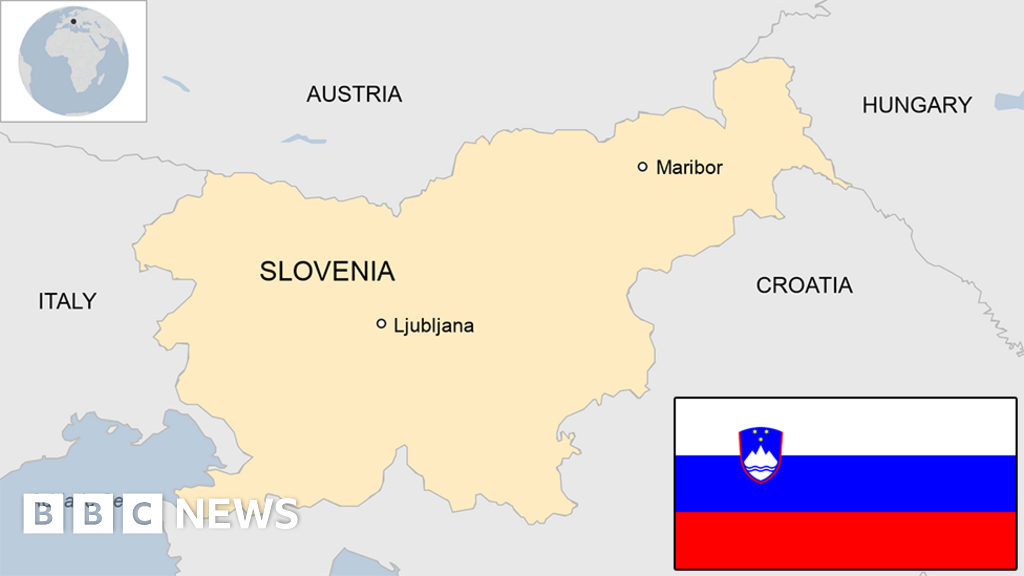Slovenia is a small country in Central Europe, but contains within its borders Alpine mountains, thick forests, historic cities, and a short Adriatic coastline.
Slovenia was the first former Yugoslav republic to join the European Union, in May 2004 – shortly after joining Nato.
Unlike Croatia or Bosnia-Herzegovina, Slovenia’s independence from Yugoslavia was swiftly won with relatively few deaths. The country also found the transition from a state economy to the free market easier than most.
Long regarded as one of the best-performing new EU members, Slovenia was dragged into a deep recession by the European financial crisis in 2012. This prompted mass protests at corruption and economic mismanagement by successive governments.
REPUBLIC OF SLOVENIA: FACTS
- Capital: Ljubljana
- Area: 20,271 sq km
- Population: 2.1 million
- Languages: Slovene, Italian, Hungarian
- Life expectancy: 77 years (men) 83 years (women)
LEADERS
President: Natasa Pirc Musar
Image source, Getty Images
Natasa Pirc Musar is Slovenia’s first female president. She won 54% of the votes cast in the second round of the country’s presidential polls on 13 November 2022. Her rival, right-wing politician and former foreign minister, Anze Logar, won 46% of the votes.
A lawyer and former journalist, Pirc Musar, said that her “first task will be to open a dialogue among all Slovenes” and vowed she would do her best to “truly be the president for all”. Human rights, the rule of law and social welfare issues were at the heart of her campaign.
The role of president is largely ceremonial, but carries authority in defence and foreign affairs.
Prime minister: Robert Golob
Image source, Getty Images
Robert Golob won a surprise victory over veteran right-wing populist Prime Minister Janez Jansa at the April 2022 parliamentary elections.His green Freedom Movement formed a coalition with the Social Democrats and the Left, and pledged to focus on environmental issues, as well as rising food and energy prices.
Image source, Getty Images
Slovenia’s media scene is diverse and free. The main papers are privately-owned.
The broadcasting sector is a mix of public and private ownership. Many households are connected to cable, satellite, or internet protocol TV (IPTV). There is an advanced digital terrestrial TV (DTT) network.
TIMELINE
Image source, Getty Images
Some key dates in Slovenia’s history:
1st-5th Centuries AD – Area is part of the Roman Empire.
6th Century – Slavic tribes migrate to the region.
c. 750 – Area comes under the rule of the Bavarians, who began spreading Christianity.
c. 790 – Region is incorporated into the Carolingian Empire.
955 – Emperor Otto I defeats the Magyars at Lechfeld. Slovene territory becomes a border region of the Holy Roman Empire.
14th Century – Most of Slovenia becomes hereditary land of the Habsburg monarchy.
19th Century – Rising nationalism and also Yugoslavism – stressing the unity of all South Slavic peoples – spreads as a reaction to Pan-German and Italian nationalism.
1914-18 – World War One sees heavy fighting in the area between the Austro-Hungarian and Italian armies – particularly the twelve Battles of the Isonzo.
1918 – After the collapse of the Austro-Hungarian empire, Slovenia joins the Kingdom of Serbs, Croats and Slovenes. The kingdom later becomes known as Yugoslavia.
1941 – Slovenia is occupied by Nazi Germany and Italy during World War Two.
1945 – At the end of the war, Slovenia becomes a constituent republic of communist Yugoslavia.
1987-1990 – Slovene Spring. Mass movement for political reform emerges.
1990 – Country changes its name to the Republic of Slovenia. Holds it first democratic elections.
1991 – Slovenia, along with Croatia, declares its independence. The Yugoslav army invades, leading to the Ten Day War. Some 65 people are killed before the EU brokers a ceasefire. The Yugoslav army withdraws.
2004 – Slovenia joins the European Union.
2011-13 – Mass protests at corruption and financial mismanagement during the European sovereign debt crisis.
Image source, Getty Images

